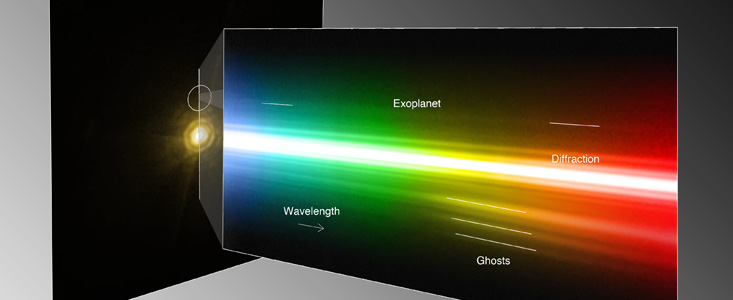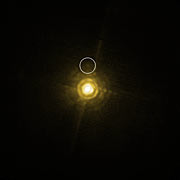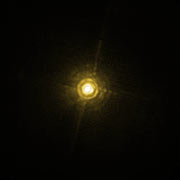Press Release
VLT Captures First Direct Spectrum of an Exoplanet
13 January 2010
By studying a triple planetary system that resembles a scaled-up version of our own Sun’s family of planets, astronomers have been able to obtain the first direct spectrum — the “chemical fingerprint” [1] — of a planet orbiting a distant star [2], thus bringing new insights into the planet's formation and composition. The result represents a milestone in the search for life elsewhere in the Universe.
“The spectrum of a planet is like a fingerprint. It provides key information about the chemical elements in the planet’s atmosphere,” says Markus Janson, lead author of a paper reporting the new findings. “With this information, we can better understand how the planet formed and, in the future, we might even be able to find tell-tale signs of the presence of life.”
The researchers obtained the spectrum of a giant exoplanet that orbits the bright, very young star HR 8799. The system is at about 130 light-years from Earth. The star has 1.5 times the mass of the Sun, and hosts a planetary system that resembles a scaled-up model of our own Solar System. Three giant companion planets were detected in 2008 by another team of researchers, with masses between 7 and 10 times that of Jupiter. They are between 20 and 70 times as far from their host star as the Earth is from the Sun; the system also features two belts of smaller objects, similar to our Solar System's asteroid and Kuiper belts.
“Our target was the middle planet of the three, which is roughly ten times more massive than Jupiter and has a temperature of about 800 degrees Celsius,” says team member Carolina Bergfors. “After more than five hours of exposure time, we were able to tease out the planet's spectrum from the host star's much brighter light.”
This is the first time the spectrum of an exoplanet orbiting a normal, almost Sun-like star has been obtained directly. Previously, the only spectra to be obtained required a space telescope to watch an exoplanet pass directly behind its host star in an “exoplanetary eclipse”, and then the spectrum could be extracted by comparing the light of the star before and after. However, this method can only be applied if the orientation of the exoplanet’s orbit is exactly right, which is true for only a small fraction of all exoplanetary systems. The present spectrum, on the other hand, was obtained from the ground, using ESO’s Very Large Telescope (VLT), in direct observations that do not depend on the orbit’s orientation.
As the host star is several thousand times brighter than the planet, this is a remarkable achievement. “It's like trying to see what a candle is made of, by observing it from a distance of two kilometres when it’s next to a blindingly bright 300 Watt lamp,” says Janson.
The discovery was made possible by the infrared instrument NACO, mounted on the VLT, and relied heavily on the extraordinary capabilities of the instrument’s adaptive optics system [3]. Even more precise images and spectra of giant exoplanets are expected both from the next generation instrument SPHERE, to be installed on the VLT in 2011, and from the European Extremely Large Telescope.
The newly collected data show that the atmosphere enclosing the planet is still poorly understood. “The features observed in the spectrum are not compatible with current theoretical models,” explains co-author Wolfgang Brandner. “We need to take into account a more detailed description of the atmospheric dust clouds, or accept that the atmosphere has a different chemical composition from that previously assumed.”
The astronomers hope to soon get their hands on the fingerprints of the other two giant planets so they can compare, for the first time, the spectra of three planets belonging to the same system. “This will surely shed new light on the processes that lead to the formation of planetary systems like our own,” concludes Janson.
Notes
[1] As every rainbow demonstrates, white light can be split up into different colours. Astronomers artificially split up the light they receive from distant objects into its different colours (or “wavelengths”). However, where we distinguish five or six rainbow colours, astronomers map hundreds of finely nuanced colours, producing a spectrum — a record of the different amounts of light the object emits in each narrow colour band. The details of the spectrum — more light emitted at some colours, less light at others — provide tell-tale signs about the chemical composition of the matter producing the light. This makes spectroscopy, the recording of spectra, an important investigative tool in astronomy.
[2] In 2004, astronomers used NACO on the VLT to obtain an image and a spectrum of a 5 Jupiter mass object around a brown dwarf — a “failed star”. It is however thought that the pair probably formed together, like a petite stellar binary, instead of the companion forming in the disc around the brown dwarf, like a star–planet system (see eso0428, eso0515 and eso0619).
[3] Telescopes on the ground suffer from a blurring effect introduced by atmospheric turbulence. This turbulence causes the stars to twinkle in a way that delights poets but frustrates astronomers, since it smears out the fine details of the images. However, with adaptive optics techniques, this major drawback can be overcome so that the telescope produces images that are as sharp as theoretically possible, i.e. approaching conditions in space. Adaptive optics systems work by means of a computer-controlled deformable mirror that counteracts the image distortion introduced by atmospheric turbulence. It is based on real-time optical corrections computed at very high speed (several hundreds of times each second) from image data obtained by a wavefront sensor (a special camera) that monitors light from a reference star.
More information
This research was presented in a paper in press as a Letter to the Astrophysical Journal (“Spatially resolved spectroscopy of the exoplanet HR 8799 c”, by M. Janson et al.).
The team is composed of M. Janson (University of Toronto, Canada), C. Bergfors, M. Goto, W. Brandner (Max-Planck-Institute for Astronomy, Heidelberg, Germany) and D. Lafrenière (University of Montreal, Canada). Preparatory data were taken with the IRCS instrument at the Subaru telescope.
ESO, the European Southern Observatory, is the foremost intergovernmental astronomy organisation in Europe and the world’s most productive astronomical observatory. It is supported by 14 countries: Austria, Belgium, Czechia, Denmark, France, Finland, Germany, Italy, the Netherlands, Portugal, Spain, Sweden, Switzerland and the United Kingdom. ESO carries out an ambitious programme focused on the design, construction and operation of powerful ground-based observing facilities enabling astronomers to make important scientific discoveries. ESO also plays a leading role in promoting and organising cooperation in astronomical research. ESO operates three unique world-class observing sites in Chile: La Silla, Paranal and Chajnantor. At Paranal, ESO operates the Very Large Telescope, the world’s most advanced visible-light astronomical observatory, and VISTA, the world’s largest survey telescope. ESO is the European partner of a revolutionary astronomical telescope ALMA, the largest astronomical project in existence. ESO is currently planning a 42-metre European Extremely Large optical/near-infrared Telescope, the E-ELT, which will become “the world’s biggest eye on the sky”.
Links
- Science paper
- More info: Exoplanet media kit
Contacts
Markus Janson
University of Toronto
Toronto, Canada
Tel: +1 416 946 5465 and +49 6221 528 493
Email: janson@astro.utoronto.ca
Wolfgang Brandner
Max-Planck-Institute for Astronomy
Heidelberg, Germany
Tel: +49 6221 528 289
Email: brandner@mpia.de
Henri Boffin
La Silla/Paranal/E-ELT PiO
ESO ePOD, Garching, Germany
Tel: +49 89 3200 6222
Email: hboffin@eso.org
About the Release
| Release No.: | eso1002 |
| Name: | HR 8799 |
| Type: | Milky Way : Star : Evolutionary Stage : Young Stellar Object |
| Facility: | Very Large Telescope |
| Instruments: | NACO |
| Science data: | 2010ApJ...710L..35J |
Our use of Cookies
We use cookies that are essential for accessing our websites and using our services. We also use cookies to analyse, measure and improve our websites’ performance, to enable content sharing via social media and to display media content hosted on third-party platforms.
ESO Cookies Policy
The European Organisation for Astronomical Research in the Southern Hemisphere (ESO) is the pre-eminent intergovernmental science and technology organisation in astronomy. It carries out an ambitious programme focused on the design, construction and operation of powerful ground-based observing facilities for astronomy.
This Cookies Policy is intended to provide clarity by outlining the cookies used on the ESO public websites, their functions, the options you have for controlling them, and the ways you can contact us for additional details.
What are cookies?
Cookies are small pieces of data stored on your device by websites you visit. They serve various purposes, such as remembering login credentials and preferences and enhance your browsing experience.
Categories of cookies we use
Essential cookies (always active): These cookies are strictly necessary for the proper functioning of our website. Without these cookies, the website cannot operate correctly, and certain services, such as logging in or accessing secure areas, may not be available; because they are essential for the website’s operation, they cannot be disabled.
Functional Cookies: These cookies enhance your browsing experience by enabling additional features and personalization, such as remembering your preferences and settings. While not strictly necessary for the website to function, they improve usability and convenience; these cookies are only placed if you provide your consent.
Analytics cookies: These cookies collect information about how visitors interact with our website, such as which pages are visited most often and how users navigate the site. This data helps us improve website performance, optimize content, and enhance the user experience; these cookies are only placed if you provide your consent. We use the following analytics cookies.
Matomo Cookies:
This website uses Matomo (formerly Piwik), an open source software which enables the statistical analysis of website visits. Matomo uses cookies (text files) which are saved on your computer and which allow us to analyze how you use our website. The website user information generated by the cookies will only be saved on the servers of our IT Department. We use this information to analyze www.eso.org visits and to prepare reports on website activities. These data will not be disclosed to third parties.
On behalf of ESO, Matomo will use this information for the purpose of evaluating your use of the website, compiling reports on website activity and providing other services relating to website activity and internet usage.
Matomo cookies settings:
Additional Third-party cookies on ESO websites: some of our pages display content from external providers, e.g. YouTube.
Such third-party services are outside of ESO control and may, at any time, change their terms of service, use of cookies, etc.
YouTube: Some videos on the ESO website are embedded from ESO’s official YouTube channel. We have enabled YouTube’s privacy-enhanced mode, meaning that no cookies are set unless the user actively clicks on the video to play it. Additionally, in this mode, YouTube does not store any personally identifiable cookie data for embedded video playbacks. For more details, please refer to YouTube’s embedding videos information page.
Cookies can also be classified based on the following elements.
Regarding the domain, there are:
- First-party cookies, set by the website you are currently visiting. They are stored by the same domain that you are browsing and are used to enhance your experience on that site;
- Third-party cookies, set by a domain other than the one you are currently visiting.
As for their duration, cookies can be:
- Browser-session cookies, which are deleted when the user closes the browser;
- Stored cookies, which stay on the user's device for a predetermined period of time.
How to manage cookies
Cookie settings: You can modify your cookie choices for the ESO webpages at any time by clicking on the link Cookie settings at the bottom of any page.
In your browser: If you wish to delete cookies or instruct your browser to delete or block cookies by default, please visit the help pages of your browser:
Please be aware that if you delete or decline cookies, certain functionalities of our website may be not be available and your browsing experience may be affected.
You can set most browsers to prevent any cookies being placed on your device, but you may then have to manually adjust some preferences every time you visit a site/page. And some services and functionalities may not work properly at all (e.g. profile logging-in, shop check out).
Updates to the ESO Cookies Policy
The ESO Cookies Policy may be subject to future updates, which will be made available on this page.
Additional information
For any queries related to cookies, please contact: pdprATesoDOTorg.
As ESO public webpages are managed by our Department of Communication, your questions will be dealt with the support of the said Department.






